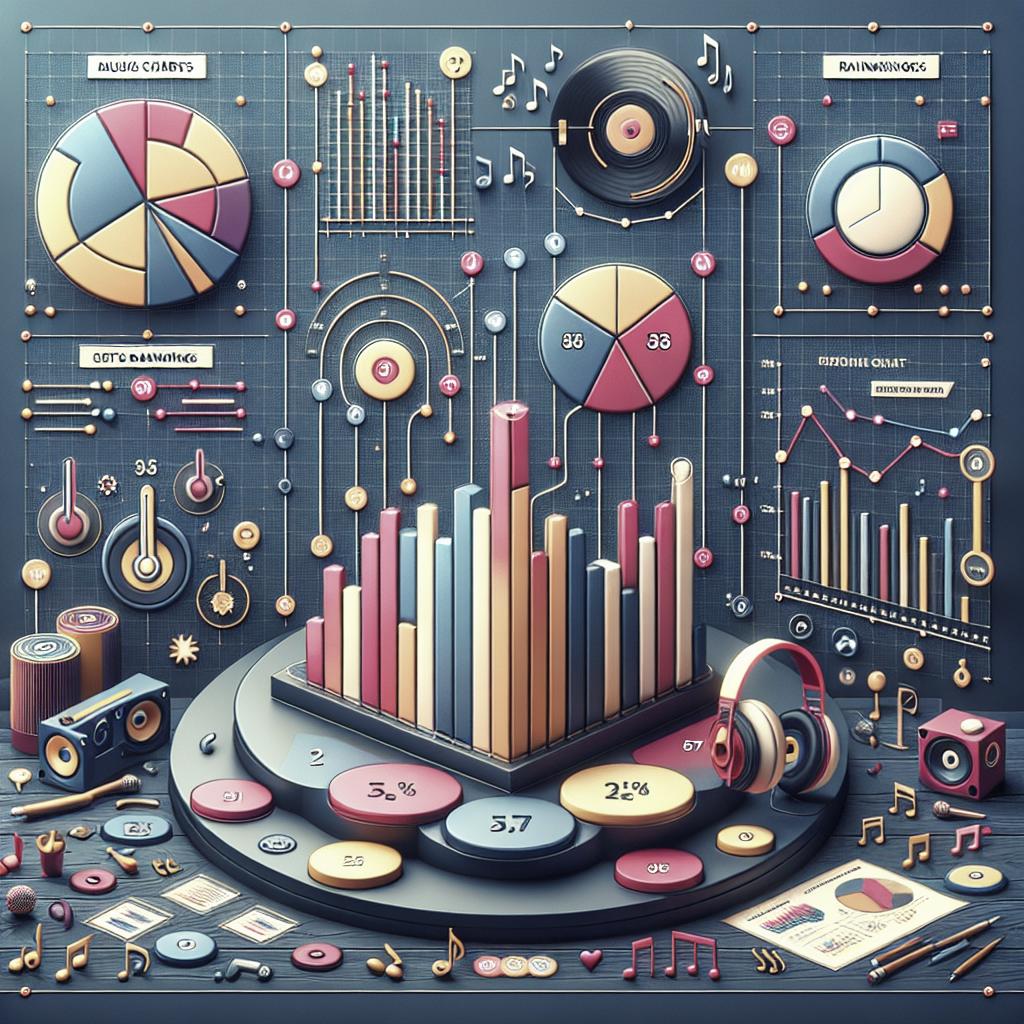“`html
How to Interpret Music Charts and Rankings
Music charts and rankings are more than just numbers. These insights serve as key indicators of an artist’s success, popularity, and potential impact on the industry. Understanding and interpreting these charts requires an analytical approach, considering elements such as sales, streaming, radio play, and social media engagement. This blog post delves into the intricacies of music charts and insights, exploring their role and utility. It also offers practical advice on accessing and leveraging these insights to benefit an artist’s career. Additionally, it examines the challenges in interpreting these metrics and speculates on future trends in this ever-evolving landscape of music analytics.
What Are Music Charts & Insights?
The Role of Music Charts
Music charts play a pivotal role in the industry by providing a snapshot of which songs or albums are trending. These rankings reflect measurable performance data such as sales and streams, offering a quantitative method to gauge a song’s popularity. By doing so, charts become a valuable tool for record labels, artists, and marketers to track trends and make informed decisions regarding promotions and outreach campaigns.
Historically, charts like Billboard’s Hot 100 have guided both consumers and industry insiders, dictating radio play and marketing strategies. A high-ranking chart position can significantly influence an artist’s career trajectory, often leading to increased opportunities, from collaborations to lucrative contracts.
Understanding Music Insights
Beyond the charts, music insights provide a deeper understanding of listener behavior and demographics. Insights refer to data-driven feedback gained from various digital platforms, highlighting how audiences interact with music content. This data encompasses engagement metrics such as likes, plays, shares, and follows across streaming services and social media platforms.
Using sophisticated analytics tools, artists and managers can identify key trends such as peak listening times, regional popularity, and preferred listening platforms. These insights are crucial for tailoring marketing strategies and maximizing engagement, ultimately driving growth and expanding an artist’s reach.
How to Access and Use Music Charts & Insights
Accessing Music Insights
Accessing music insights often involves utilizing various platforms and tools designed specifically for music analytics. Many streaming services like Spotify and Apple Music offer built-in analytics tools that provide artists with valuable insights into their audience’s behavior. Additionally, social media platforms have their own analytical dashboards, offering detailed data on engagement and audience demographics.
Third-party services like Chartmetric or Next Big Sound aggregate data from multiple platforms, giving a comprehensive view of an artist’s performance across different channels. These services often require a subscription, but the depth of information they provide can be invaluable for strategic planning.
Using Insights to Improve Your Strategy
Once accessed, these insights enable artists and managers to refine their strategies and maximize their impact. For example, understanding which songs perform better regionally can help tailor tour locations and promotional efforts to maximize engagement in specific markets. Additionally, identifying key listener demographics allows for creating targeted marketing campaigns that resonate with intended audiences.
Insights can also guide content creation decisions, helping artists understand which themes or styles resonate most with their audience. By aligning content with audience expectations and preferences, artists can build a loyal fan base and foster deeper connections with their listeners.
The Impact of Music Charts & Insights on an Artist’s Career
Boosting Visibility
Appearing on popular music charts can significantly boost an artist’s visibility, not just to fans but also to industry professionals such as producers, agents, and brand marketers. A high chart position often acts as a seal of approval, signaling quality and mass appeal. This visibility can translate into performance opportunities at festivals, increased media coverage, and lucrative brand partnerships.
For emerging artists, charting can serve as a breakthrough moment, opening doors that might otherwise remain closed. In a crowded music industry, charts provide a platform for new voices to be heard and recognized.
Guiding Creative Decisions
Beyond commercial success, charts and insights influence the creative direction of music production. By understanding what resonates with listeners, artists can hone their creative expression to align with audience preferences, ensuring that future projects receive a positive reception.
This feedback loop can motivate artists to experiment with new genres or collaborations, fostering innovation and creativity. Moreover, it provides a tangible measure of an artist’s evolution and development over time, reflecting shifts in public taste and cultural trends.
Enhancing Fan Engagement
Music insights also play a crucial role in enhancing fan engagement by allowing artists to connect more personally with their audience. Data regarding fan interactions help artists tailor their communication and engagement strategies, whether by releasing exclusive content or scheduling interactive Q&A sessions during optimal times.
These personalized interactions help cultivate a dedicated fan base, transforming casual listeners into committed supporters. Enhanced fan engagement not only increases an artist’s reach but also contributes to sustained longevity in their career.
Challenges in Interpreting Music Charts & Insights
Interpreting music charts and insights is not without challenges. As the music industry becomes increasingly digital, the sheer volume and variety of data can be overwhelming. Distinguishing between meaningful data and noise requires an analytical mindset and appropriate tools to sift through information effectively.
Another challenge lies in the discrepancies in data collection and reporting methodologies across platforms, which can lead to inconsistent insights. Different platforms may place varying weight on metrics such as streams, downloads, and social media engagement, complicating cross-platform analysis. Navigating these complexities demands both technical proficiency and industry-specific knowledge.
Future Trends in Music Charts & Insights
As technology continues to advance, the future of music charts and insights is poised for evolution. With the increasing influence of artificial intelligence and machine learning, the accuracy and depth of insights are expected to deepen, providing more nuanced understanding of listener behaviors and predictive trends.
Blockchain technology might play a crucial role in ensuring transparency and accuracy in data reporting and distribution, addressing current challenges related to discrepancies. Moreover, the growing significance of global music consumption patterns is likely to influence chart methodologies, reflecting diverse regional preferences and broadening the scope of what defines mainstream success.
Summary of Main Points
| Section | Summary |
|---|---|
| What Are Music Charts & Insights? | Explores the significance of charts and insights, highlighting their role in quantifying popularity and providing data-driven feedback. |
| How to Access and Use Music Charts & Insights | Details methods to access insights through platforms and tools and how they aid strategic planning and content creation. |
| The Impact on an Artist’s Career | Discusses how charts boost visibility, influence creative decisions, and enhance fan engagement. |
| Challenges | Describes the complexity in interpreting diverse data and the discrepancies in methodologies across platforms. |
| Future Trends | Predicts the impact of AI and blockchain on enhancing data accuracy and reflecting global consumption trends. |
Related Articles:
“`

